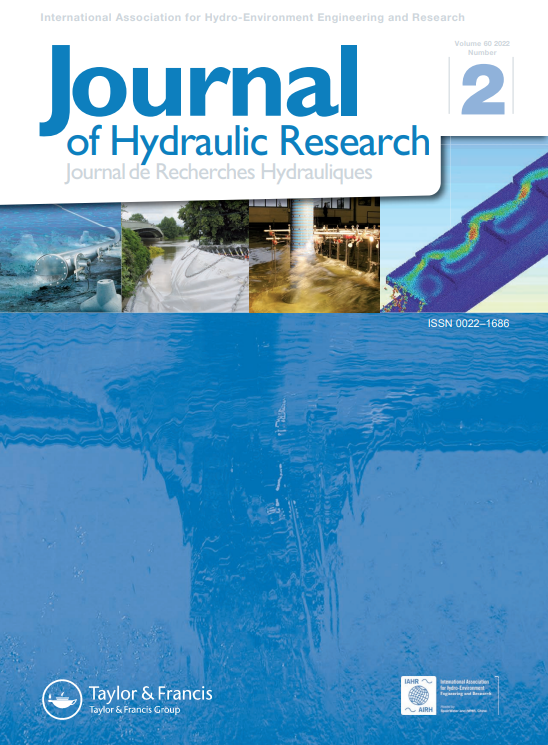Journal of Hydraulic Research | Vol. 60. Issue 2, 2022
The Journal of Hydraulic Research (JHR) publishes research papers in theoretical, experimental and computational hydraulics and fluid mechanics, relating to rivers, lakes, estuaries, coasts, constructed waterways, and some internal flows such as pipe flows. To reflect current trends in water research, articles that explore outcomes of interdisciplinary hydro-environment studies with a strong fluid mechanical component are especially welcome. Although preference is given to fundamental issues, papers focusing on important unconventional or emerging applications of broad interest are also appreciated.
IAHR members can access the latest issue online.
Overview
This issue contains an interesting and well written vision paper that addresses the numerical approaches currently used for modelling tidal flows and marine turbines and highlights future challenges in this field envisaged by the authors. The remaining papers provide novel contributions to turbulence, flow stability, flow-vegetation interaction, cavitation, sedimentation, hydraulic transients and geysering, transport of eggs of sturgeon species, and numerical computation.
Vision paper
Modelling marine turbine arrays in tidal flows 
Peter K. Stansby and Pablo Ouro
Pages: 187- 204 | DOI: 10.1080/00221686.2021.2022032
Research papers
Large-eddy simulation of turbulent free surface flow over a gravel bed
Zhihua Xie, Binliang Lin, Roger A. Falconer, Andrew Nichols, Simon J. Tait and Kirill V. Horoshenkov
Pages: 205-219 | DOI: 10.1080/00221686.2021.1908437
Analytical solution for the Kelvin–Helmholtz instability under a submerged canopy-oscillatory flow
Alejandro Cáceres-Euse, Alejandro Orfila, Maryam Abdolahpour, Francisco Toro-Botero, Evan Variano and Andres Fernando Osorio-Arias
Pages: 220-228 | DOI: 10.1080/00221686.2021.1908439
Effects of diameter, density, and adhesiveness on settling velocity and drag coefficient of two sturgeon species eggs in flow
Yujun Yi, Wenfei Jia, Yufeng Yang and Shanghong Zhang
Pages: 229-239 | DOI: 10.1080/00221686.2021.1944919
Hydrodynamic characteristics of flow over emergent vegetation in a strongly curved channel
Yu Yang, Ying-Tien Lin and Xiaoyan Ji
Pages: 240-257 | DOI: 10.1080/00221686.2021.1944920
Submerged floating tunnel cross-section analysis using a transition turbulence model 
Pengxu Zou, Jeremy D. Bricker and Wim Uijttewaal
Pages: 258-270 | DOI: 10.1080/00221686.2021.1944921
Identification of 1-D cavitation model parameters by means of computational fluid dynamics 
Jean Decaix, Sebastien Alligne, Andres Müller, Christophe Nicolet, Cecile Münch and François Avellan
Pages: 271-282 | DOI: 10.1080/00221686.2021.1944922
Characteristics of the flow field within a developing scour hole at a submerged weir
Wen Zhang, Lu Wang, Bruce W. Melville, Dawei Guan, Colin N. Whittaker and Asaad Y. Shamseldin
Pages: 283-294 | DOI: 10.1080/00221686.2021.1944928
Numerical analysis of transient cavitating pipe flow by Quasi 2D and 1D models
Maryam Mousavifard and Reyhaneh Norooz
Pages: 295-310 | DOI: 10.1080/00221686.2021.2001586
Vortex shedding and evolution induced by the interactions between a solitary wave and a submerged horizontal plate
Congfang Ai, Yuxiang Ma, Changfu Yuan, Zhihua Xie, Guohai Dong and Thorsten Stoesser
Pages: 311-325 | DOI: 10.1080/00221686.2021.2001594
Hydraulic transient evaluation via fabricable impedance matrix for pipe networks
Sang Hyun Kim
Pages: 326-340 | DOI: 10.1080/00221686.2021.2001592
Numerical study on the mechanisms of storm geysers in a vertical riser-chamber system
Jiachun Liu, Yu Qian, David Z. Zhu, Jian Zhang, Stephen Edwini-Bonsu and Fayi Zhou
Pages: 341-356 | DOI: 10.1080/00221686.2021.2001589
Technical note
Separation in overflow spillways: a computational analysis
Elias Wehrmeister and José J. Ota
Pages: 357-362 | DOI: 10.1080/00221686.2021.1908438
Correction
Correction
Pages: iii-iii | DOI: 10.1080/00221686.2021.1938437